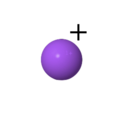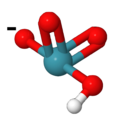 | |||
 | |||
| |||
| Identifiers | |||
|---|---|---|---|
3D model (JSmol) | |||
| |||
| |||
| Properties | |||
| NaHXeO4 | |||
| Molar mass | 219.29 g/mol | ||
| Appearance | White solid | ||
| Soluble, decomposes in water [1] | |||
| Solubility | insoluble chloroform, methanol, ethanol, and carbon tetrachloride [1] | ||
| Hazards | |||
| Occupational safety and health (OHS/OSH): | |||
Main hazards | extremely unstable, vigorous oxidizer | ||
| NFPA 704 (fire diamond) | |||
| Flash point | Non-Flammable | ||
Except where otherwise noted, data are given for materials in their standard state (at 25 °C [77 °F], 100 kPa). | |||
Monosodium xenate is the sodium salt of xenic acid with formula NaHXeO4. It is a powerful oxidizer, owing to being a highly reactive compound of xenon. [2]


